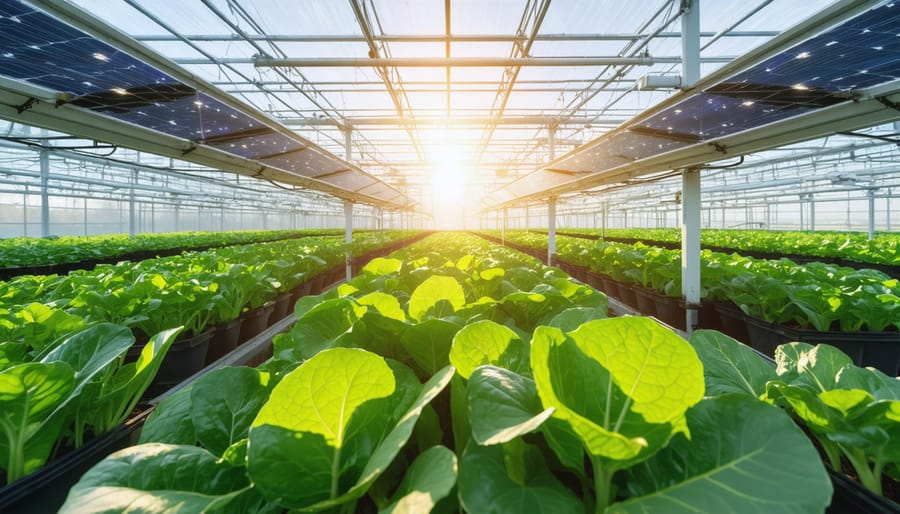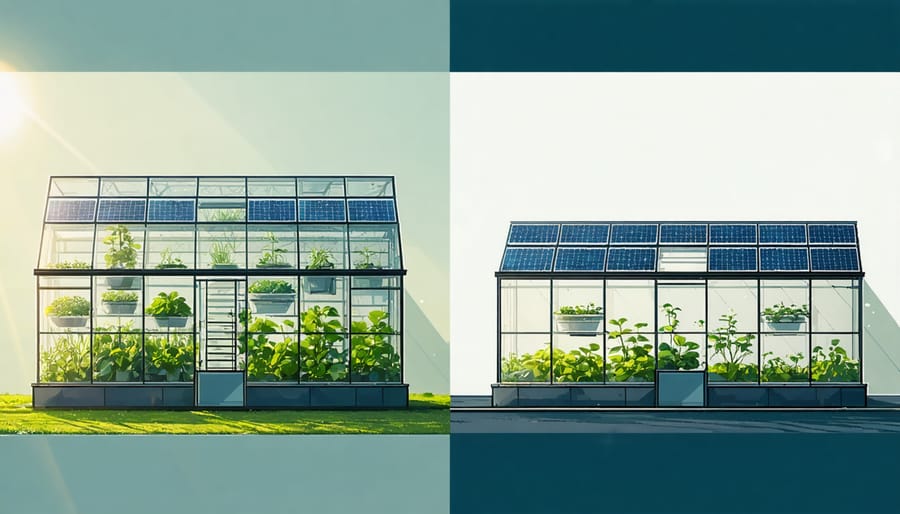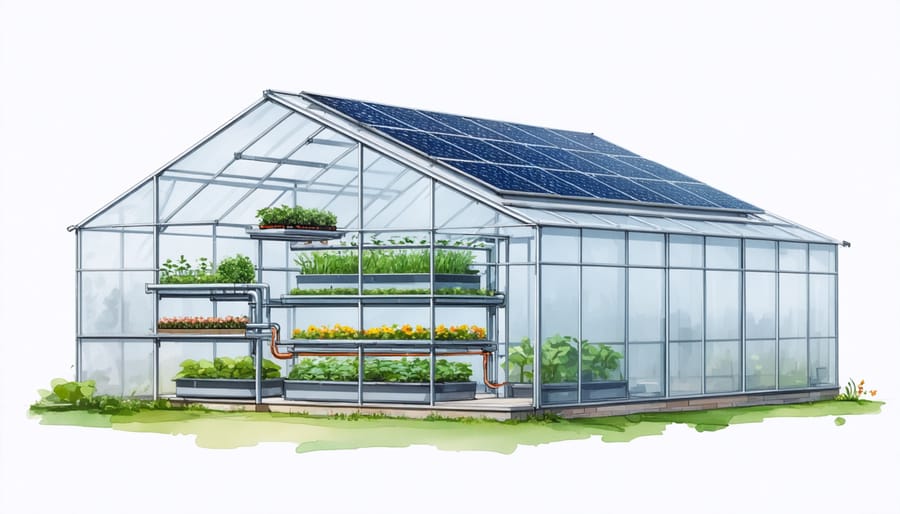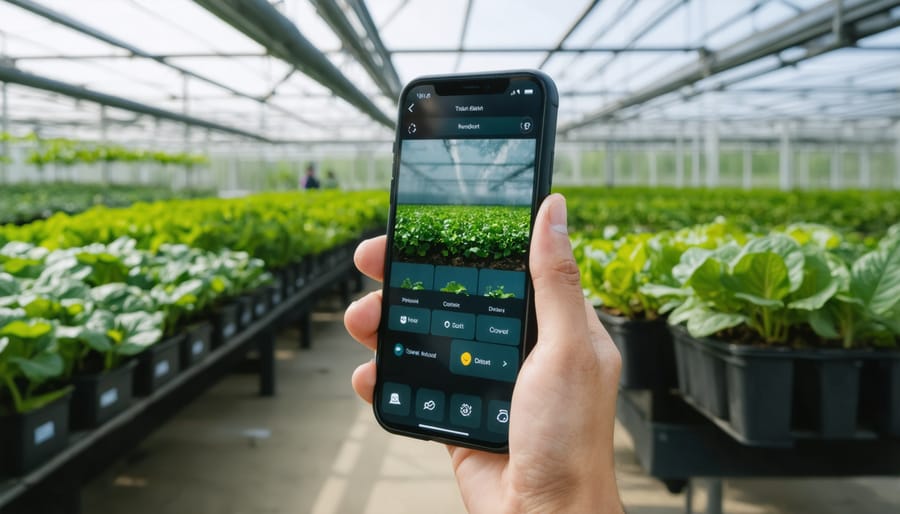Smart Solar Ventilation Transforms Greenhouse Growing (Here’s How)

Harness the sun’s dual potential in modern greenhouse operations by integrating solar-powered ventilation systems that simultaneously generate clean energy and maintain optimal growing conditions. Advanced solar greenhouse kits now enable precise temperature control while reducing operational costs by up to 70%. This innovative approach combines photovoltaic panels with smart ventilation controls, transforming traditional greenhouse management into a sustainable, energy-independent system. European growers implementing these solutions report significantly improved crop yields and reduced carbon footprints, while benefiting from year-round climate stability regardless of external weather conditions. As energy costs continue to rise across Europe, solar-powered ventilation represents a critical advancement in sustainable agriculture, offering both environmental and economic advantages for commercial and residential greenhouse operations.
Why Solar-Powered Ventilation Makes Perfect Sense for Greenhouses
The Perfect Energy Match
One of nature’s most elegant synchronicities occurs in greenhouse ventilation: the timing of peak ventilation needs perfectly matches peak solar power generation. During the warmest hours of the day, when greenhouses require maximum ventilation to maintain optimal growing conditions, solar panels reach their highest electricity production capacity.
This natural alignment means that solar-powered ventilation systems operate at their most efficient precisely when they’re needed most. As the sun intensifies and temperatures rise, typically between 10:00 and 16:00, solar panels generate maximum power to drive ventilation fans and cooling systems. This correlation ensures reliable performance without the need for extensive battery storage systems.
In European climates, this relationship becomes particularly advantageous during summer months when greenhouses face the greatest cooling demands. The extended daylight hours characteristic of European summers provide abundant solar energy for ventilation needs, creating a sustainable and cost-effective solution for greenhouse climate control. This natural synchronization makes solar power an ideal energy source for greenhouse ventilation systems.

Cost and Environmental Benefits
Implementing solar-powered ventilation in greenhouses offers significant financial and environmental advantages that align with modern sustainable agricultural practices. Operating costs decrease substantially, as these systems eliminate electricity expenses associated with traditional ventilation methods. Studies indicate that greenhouse operators can reduce their energy costs by 60-80% annually after the initial investment.
The environmental impact is equally impressive. A typical solar-powered ventilation system can prevent approximately 2.5 tonnes of CO2 emissions per year for a medium-sized greenhouse. This reduction contributes significantly to lowering the carbon footprint of agricultural operations. Additionally, these systems require minimal maintenance, further reducing both operational costs and resource consumption.
The return on investment period typically ranges from 3 to 5 years, depending on the greenhouse size and local solar conditions. When factoring in current European energy prices and available renewable energy incentives, the financial benefits become even more attractive for greenhouse operators. The combination of energy independence, reduced operational costs, and environmental stewardship makes solar-powered ventilation a compelling investment for modern greenhouse operations.
Essential Components of Solar Greenhouse Ventilation

Solar Panels and Power Systems
The heart of a solar-powered greenhouse ventilation system lies in its carefully selected solar components. A typical setup requires photovoltaic (PV) panels with a capacity between 100W to 300W, depending on the greenhouse size and ventilation needs. For optimal performance, monocrystalline or polycrystalline panels are recommended, offering efficiency rates of 15-20% and excellent durability in European weather conditions.
The system requires a charge controller (rated 10-30A) to regulate power flow and protect batteries from overcharging. Deep-cycle batteries, typically 12V or 24V systems with 100-200Ah capacity, ensure consistent operation during cloudy periods and nighttime. For maximum efficiency, AGM or lithium-ion batteries are preferred due to their longer lifespan and better performance in varying temperatures.
An inverter rated between 500W to 1500W is essential to convert DC power from the panels to AC power for ventilation motors. The exact specifications depend on the total power requirements of your ventilation fans and control systems. For enhanced system monitoring, smart controllers can be integrated to automatically adjust ventilation based on temperature and humidity levels.
When designing your system, factor in a 20% power surplus to account for efficiency losses and future expansion needs. Professional installation ensures optimal panel positioning, typically at a 30-45 degree angle for maximum solar exposure in European latitudes.
Ventilation Equipment and Controls
Modern greenhouse ventilation systems rely on a sophisticated combination of solar-powered ventilation equipment and smart controls to maintain optimal growing conditions. The primary components include DC-powered exhaust fans, circulation fans, and intake shutters, all designed to operate efficiently on solar power.
Temperature and humidity sensors form the backbone of the control system, continuously monitoring environmental conditions. These sensors communicate with automated controllers that adjust ventilation rates based on predetermined parameters. Modern systems often incorporate CO2 sensors to ensure optimal atmospheric conditions for plant growth.
The most commonly used fans include:
– Variable-speed DC exhaust fans (30-120cm diameter)
– Horizontal air flow fans for circulation
– High-efficiency brushless motor designs
– Solar-direct drive options with battery backup
Smart controllers have evolved to offer sophisticated features such as:
– WiFi connectivity for remote monitoring
– Multi-zone control capabilities
– Automated emergency protocols
– Data logging and analysis tools
– Weather-responsive programming
These systems typically integrate with motorised vents and shutters that work in harmony with the fans to create balanced airflow patterns. Light sensors can trigger specific ventilation protocols based on solar intensity, while intelligent algorithms adapt ventilation strategies according to seasonal changes.
For enhanced reliability, many systems incorporate hybrid power management, seamlessly switching between solar power and grid electricity when necessary. This ensures consistent ventilation even during periods of limited sunlight, while still maximising the use of renewable energy.
The latest innovations include predictive control systems that use weather forecasts to optimise ventilation strategies proactively, ensuring energy efficiency while maintaining ideal growing conditions. These smart systems can significantly reduce energy consumption while improving crop yields through precise climate control.
Smart Integration and Automation Features
Climate Control Intelligence
Modern greenhouse ventilation systems leverage advanced sensor technology and smart automation systems to maintain optimal growing conditions while maximizing energy efficiency. These intelligent control systems utilize a network of strategically placed sensors to monitor crucial environmental parameters including temperature, humidity, CO2 levels, and light intensity in real-time.
The system’s brain, typically a microcontroller or programmable logic controller, processes this sensor data and automatically adjusts ventilation components according to predetermined parameters. When temperatures rise above desired levels, the controller activates solar-powered fans or opens motorized vents, maintaining ideal growing conditions without manual intervention.
Advanced systems also incorporate weather stations that monitor external conditions, allowing the system to anticipate and respond to changing weather patterns. This predictive capability enables proactive adjustments rather than reactive responses, ensuring consistent climate control while optimizing energy usage.
Many modern solutions offer remote monitoring and control capabilities through smartphone applications or web interfaces, enabling greenhouse operators to monitor conditions and adjust settings from anywhere. The systems can also generate detailed performance reports and analytics, helping operators optimize their climate control strategies over time while identifying potential maintenance needs before they become critical issues.
Remote Monitoring and Management
Modern solar-powered greenhouse ventilation systems benefit greatly from sophisticated remote monitoring and management capabilities. Through smart controllers and IoT-enabled devices, operators can monitor and adjust their ventilation systems from anywhere using smartphones or computers.
These digital management systems typically include real-time monitoring of crucial parameters such as temperature, humidity, CO2 levels, and solar power generation. Advanced sensors throughout the greenhouse continuously collect data, while integrated software presents this information through user-friendly dashboards.
Automated controls allow for precise adjustment of ventilation components based on predetermined settings or real-time conditions. Users can set specific thresholds for temperature and humidity, triggering automatic responses from fans and vents when needed. The system can also optimise energy usage by coordinating ventilation with available solar power.
Many platforms offer alert systems that notify operators about unusual conditions or system malfunctions, enabling quick responses to potential issues. Historical data logging helps in analysing long-term performance trends and making informed decisions about system optimisation.
For commercial operations, these management systems often include features for multiple greenhouse zones and can integrate with broader facility management systems. Regular software updates ensure system security and provide access to new features, while cloud storage keeps operational data secure and accessible.
This digital oversight not only improves operational efficiency but also contributes to better crop yields through more precise environmental control.

Installation and Maintenance Considerations
Professional Installation Requirements
The successful installation of a solar-powered greenhouse ventilation system requires careful planning and professional expertise. A qualified installer should begin with a comprehensive site assessment, evaluating factors such as the greenhouse orientation, solar exposure patterns, and structural integrity of the mounting surfaces.
Key installation requirements include proper positioning of solar panels to maximise sun exposure, typically at a 30-45 degree angle for optimal performance in European latitudes. The ventilation components must be strategically placed to ensure uniform air circulation throughout the greenhouse space, with intake vents positioned low and exhaust fans mounted high for natural thermal flow.
Electrical integration demands particular attention, with proper sizing of cables, implementation of charge controllers, and installation of deep-cycle batteries for energy storage. All electrical work must comply with local regulations and safety standards, including proper grounding and weather-resistant connections.
The control system installation requires careful calibration of temperature sensors and automation components. Professionals should establish appropriate trigger points for fan activation based on specific crop requirements and local climate conditions.
For enhanced system reliability, installers should implement proper cable management, protect all components from moisture, and ensure adequate ventilation for electrical equipment. Documentation of the installation, including system specifications and operational parameters, should be provided to the facility operator for future reference and maintenance purposes.
Ongoing Maintenance and Optimization
To ensure optimal performance of your solar-powered greenhouse ventilation system, implementing a regular maintenance schedule is essential. Begin with monthly inspections of solar panels, removing any dust, leaves, or debris that might reduce their efficiency. In European climates, particularly during autumn, this becomes especially important due to falling leaves and increased precipitation.
Check all electrical connections quarterly for signs of wear or corrosion, and ensure that wiring remains properly insulated and protected from environmental factors. Fan units should be cleaned monthly, with special attention to removing accumulated dirt that could affect their operation. Lubricate moving parts according to manufacturer specifications, typically every six months.
Monitor your system’s performance through available metrics, keeping a log of energy production and ventilation effectiveness. This data helps identify potential issues before they become significant problems. During winter months, pay particular attention to thermostat settings and adjust them according to changing daylight hours and temperature patterns.
For optimization, consider seasonal adjustments to fan speeds and temperature thresholds. In spring and autumn, when temperature fluctuations are more frequent, fine-tune your system’s response times. Install weather stations or smart controllers to automatically adjust ventilation based on real-time conditions.
Regular maintenance not only extends system longevity but also ensures consistent energy efficiency. Consider scheduling professional inspections annually to validate system performance and identify potential upgrades or improvements that could enhance operation.
Solar-powered greenhouse ventilation systems represent a significant step forward in sustainable agriculture and horticultural practices. By harnessing clean, renewable solar energy to power ventilation systems, greenhouse operators can achieve substantial reductions in operational costs while contributing to environmental preservation. The combination of reduced energy consumption and improved growing conditions makes these systems an invaluable investment for both small-scale and commercial greenhouse operations.
The benefits extend beyond mere cost savings. These systems offer enhanced reliability through reduced dependence on grid power, improved crop yields through consistent climate control, and minimal maintenance requirements. For European growers, the adoption of solar ventilation aligns perfectly with the continent’s ambitious climate goals and growing emphasis on sustainable farming practices.
As we move towards a more sustainable future, the implementation of solar-powered ventilation systems in greenhouses becomes not just an option, but a practical necessity. The initial investment is increasingly offset by long-term savings, government incentives, and improved operational efficiency. Whether you operate a small hobby greenhouse or manage a large commercial facility, solar ventilation technology offers a proven solution for maintaining optimal growing conditions while reducing environmental impact.
We encourage greenhouse operators to explore these innovative solutions and consult with qualified solar installation professionals to determine the most suitable system for their specific needs. The future of greenhouse cultivation is sustainable, efficient, and solar-powered.
Leave a Reply